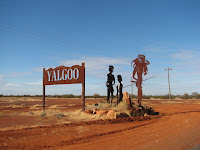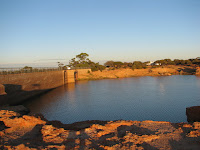































BLOG 9 SANDSTONE
On our next leg between Leonora and Sandstone, a distance of 280klms., we stopped at Agnew. The only service was the hotel, but was closed. Agnew also a very old settlement in the gold rush days.
Peter Denny Lookout 39klm east of Sandstone is where we camped for the night.( CAMPS 5, #349) A beautiful rest area overlooking what they call the “Breakaways”. D’Arcy went on the lookout for dead wood for our fire and had a lovely night cooking dinner outside and enjoying the night, especially since the flies had gone to bed. Of course the detector came out for another whizz around but no luck yet. Still learning.
Sandstone has an extremely interesting history which used to be a bustling city with 6000-8000 people during the gold rush days. A very clean and pretty town, with the main street being very wide, as with most of the outback towns, and beautiful displays of bouganvillia. We did meet the lady gardener who looks after the towns gardens after a visit to the local National Hotel one evening. It is always good to visit the hotels and meet the locals and regular visitors. The Sandstone Heritage Trail takes you on a 18klm self-guided walk/drive through the town and surrounding district, featuring historical sites. London Bridge is part of a larger formation about 800mtrs long and varying in height from around 3-10mtrs. It is believed to be about 350million yrs. old. “London Bridge is falling down” unfortunately with time the bridge is getting thinner & thinner and will eventually fall. It is a popular lookout spot and picnic area. Mind you, I did walk quite quickly under it. You just never know. The old Post & Telegraph Office now doubles as the general store, supplying most things as well as fuel. There is a visitor centre which are always full of history and information. We always make it a point of going into these places to get an insight of the area and what there is to see & visit.
14th April and 158klms. west is the township of Mt. Magnet. Although there are a lot of active mining areas around Mt. Magnet we did find out the places we could go and prospect from the local mining office. The lady there was very helpful to us, printing out maps etc. The caravan park was also well maintained and very comfortable. It is probably the first time we have used a camp kitchen, which was just beside our site. It was very well stocked with cooking facilities and utensils, including a t.v. On one of our prospecting trips, not finding anything of value, we returned back to town to discover we had lost our miners pick. Unable to buy another one anywhere in town it was decided to head back out (40klms each way)to where we last were. Unsuccessful. We did have a smaller alternative version but not as good.
123klms. west of Mt. Magnet was Yalgoo, but we decided to go via Paynes Find, 145klms. south, where we thought we would camp, but the roadhouse was closed due to recent storm damage, so no facilities, fuel or food available. After a brief chat to some fellow travellers, we headed north to Yalgoo, which was 156klms. north on a gravel road for 78klms. then bitumen for 78klms. We saw no vehicles for 3hrs.5mins. The only wild life, 2 emus and 2 small goannas. We did stop for lunch and a bit of a poke around but only a lot of tins etc. remains of old prospectors camps.
We arrived in Yalgoo on their Race Day, yearly event, which was a Saturday. The caravan and camping ground was opposite the race track and controlled by the local shire, of course it was closed so we parked up in a generator area up the back. Didn’t get to race track, but we heard it all. After the races they had 2 up games going and also entertainment with great music. We were able to sit out and listen to it all and then watch as people started leaving. A beautiful little oasis of a camp spot. The centre of the grounds was a circle of lovely green grass with powered sites around the perimeter. These all became available the next morning when everyone vacated and we moved ourselves into one. A visit to to the local museum was very interesting. Included was a replica of the courthouse with a lot of history of trials etc. Also a “quaint” little catholic church, which did at one time have a convent attached, but was removed and re-located some years ago.
19th April and we arrived in Geraldton in time for the Easter Holidays. Our first night was a visit to the family, Kim, Steve & Kyle where Kim had prepared dinner . After getting our shopping done and preparing for Easter, D’Arcy was invited to go with the “boys” on Steve’s boat for a day out to the Abrolohos Islands fishing. Although they had no luck with the fishing a good day was had by all. My treat for Good Friday was a visit from a lovely friend, Tana with husband Dave and children, Teagan & Danika, who are from Perth, but were in Geraldton for the Easter break. Grandson, Lance had come up from Perth, as did his uncle, John & son, Tristin. Easter Sat. we all packed up our camp gear and travelled approx. 170klms. NE of Geraldton to Yuin Station near the river. We had a great weekend in the bush, of course accompanied by all the flies, but good when nightime came and they went to bed. We sat by the camp fire, went prospecting and exploring. D’Arcy taught the younger boys how to handle firearms safely before target practice was set up using cans, boxes etc. Yes, the adults had their skills put to test too. Doing fairly good. Easter was not forgotten by the “bunny” for an egg hunt.
Then come Easter Monday, also Anzac Day, and daughter Jackie’s birthday, was time to pack up and head back to Geraldton.































